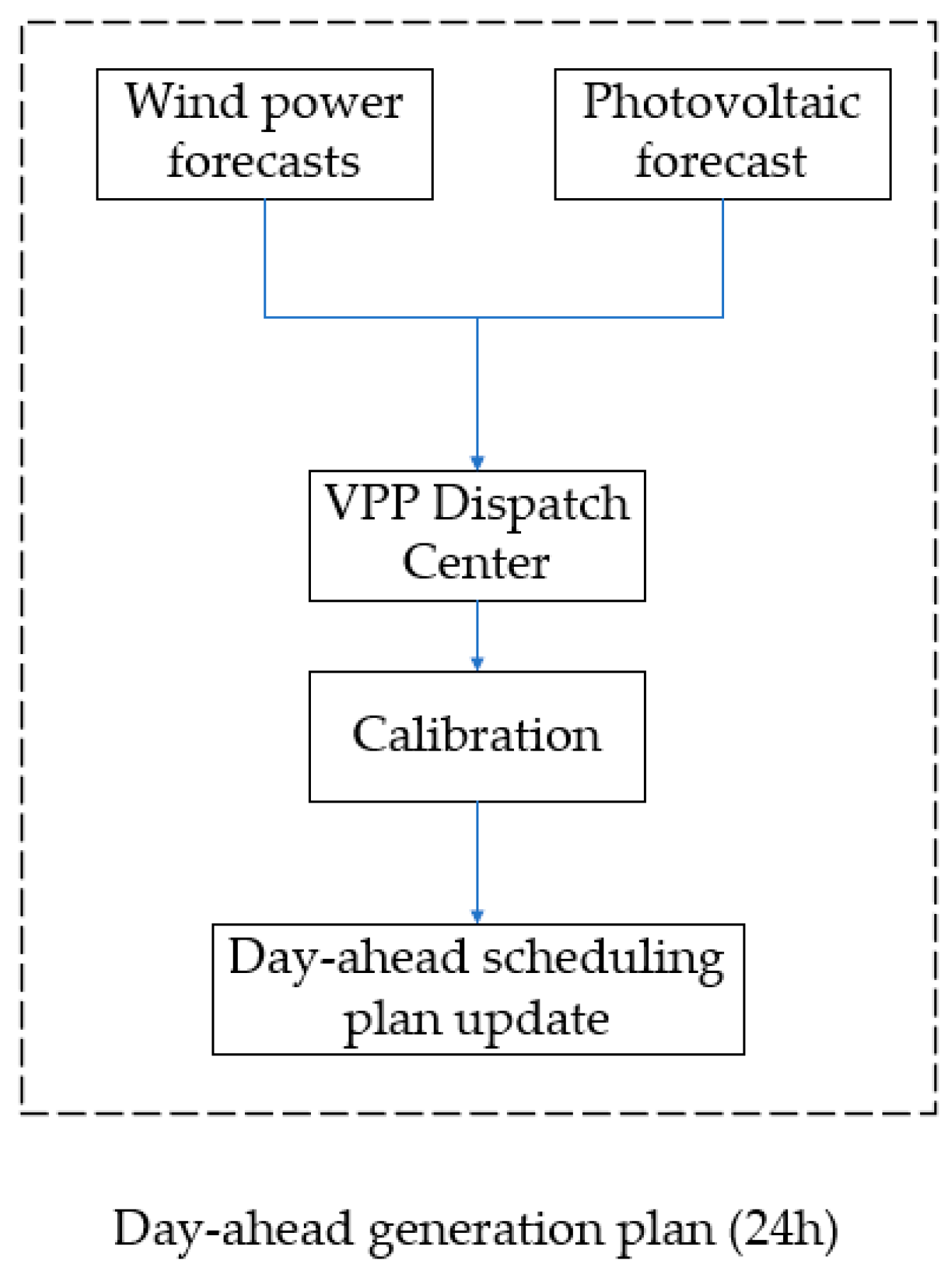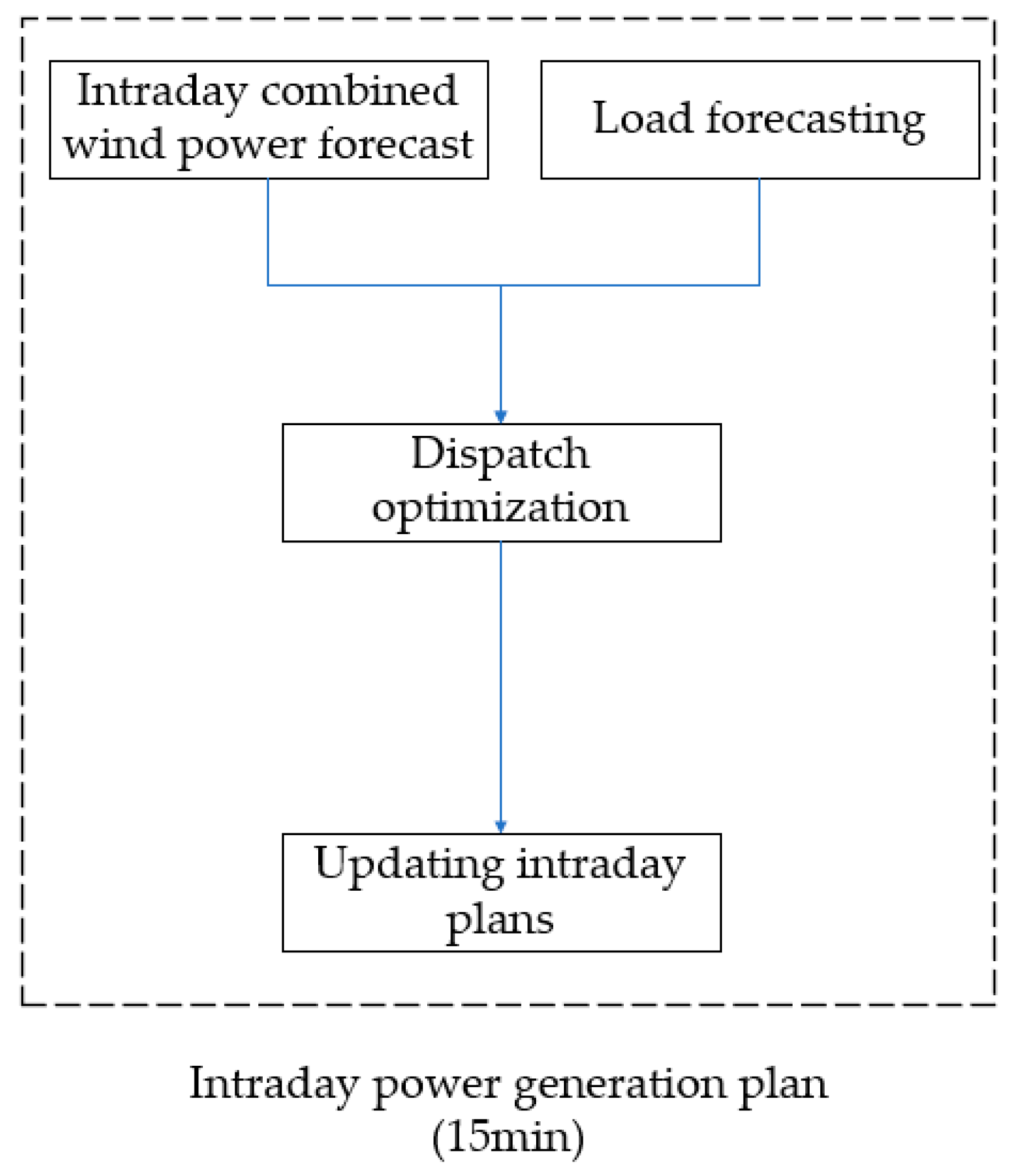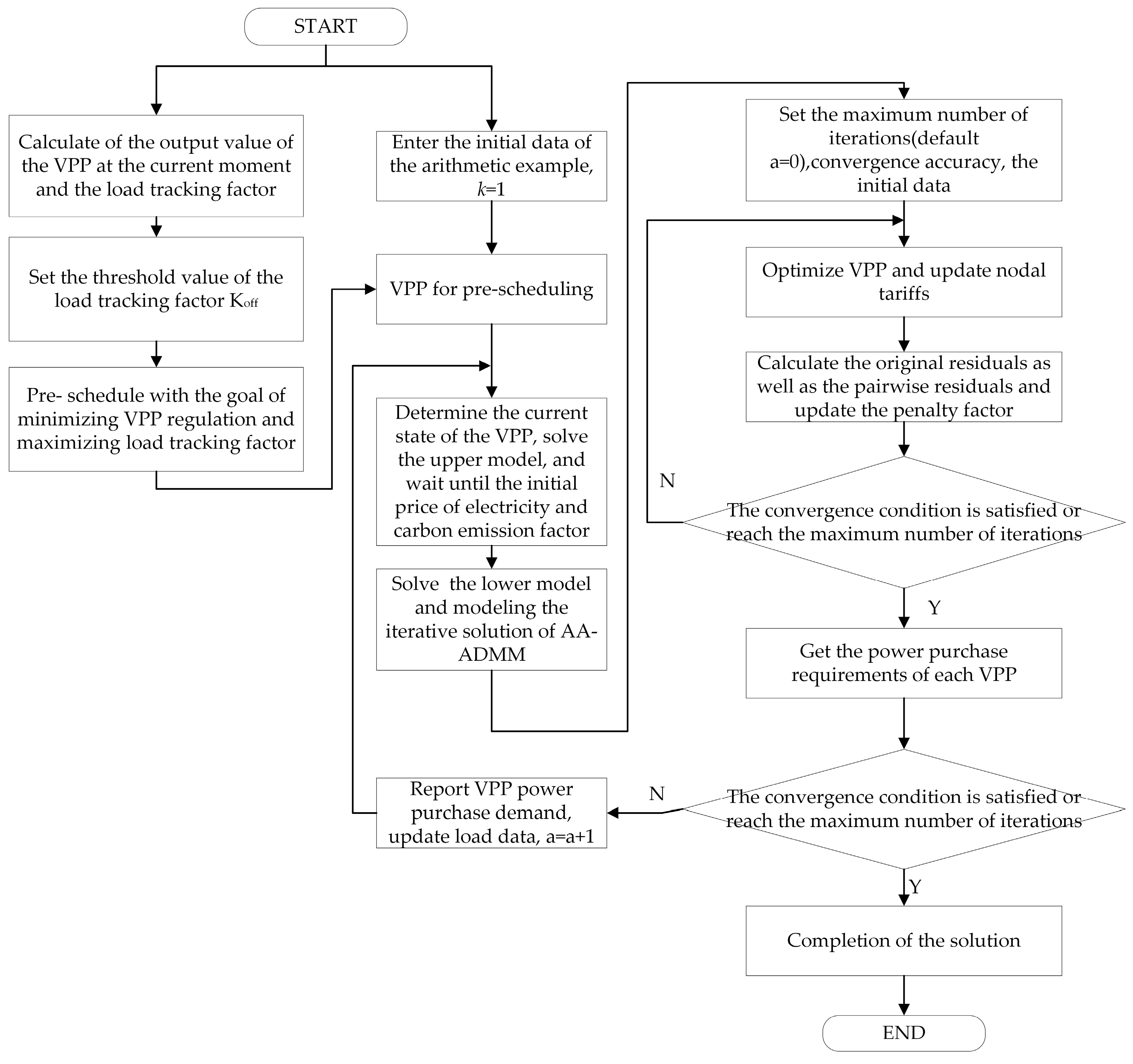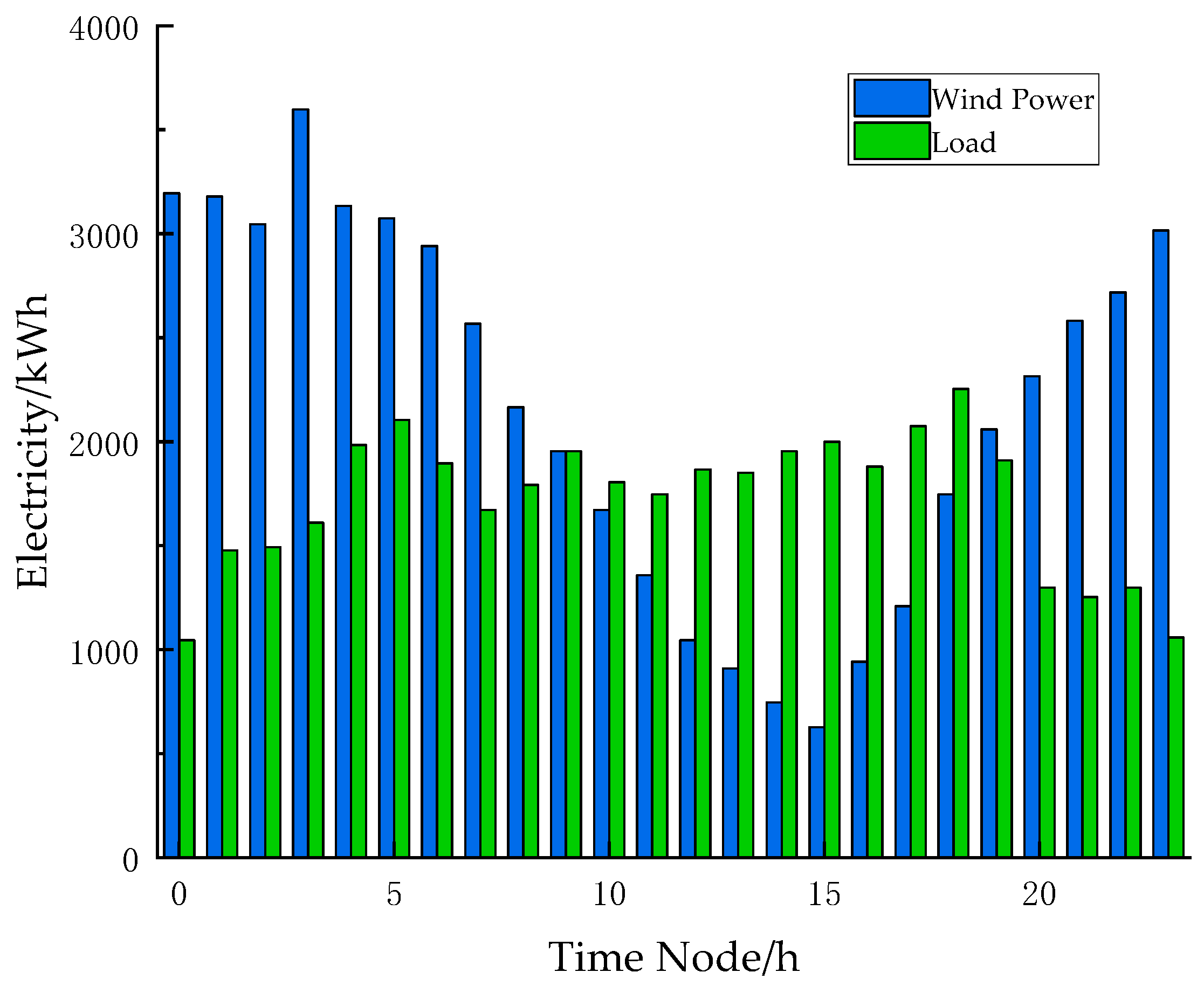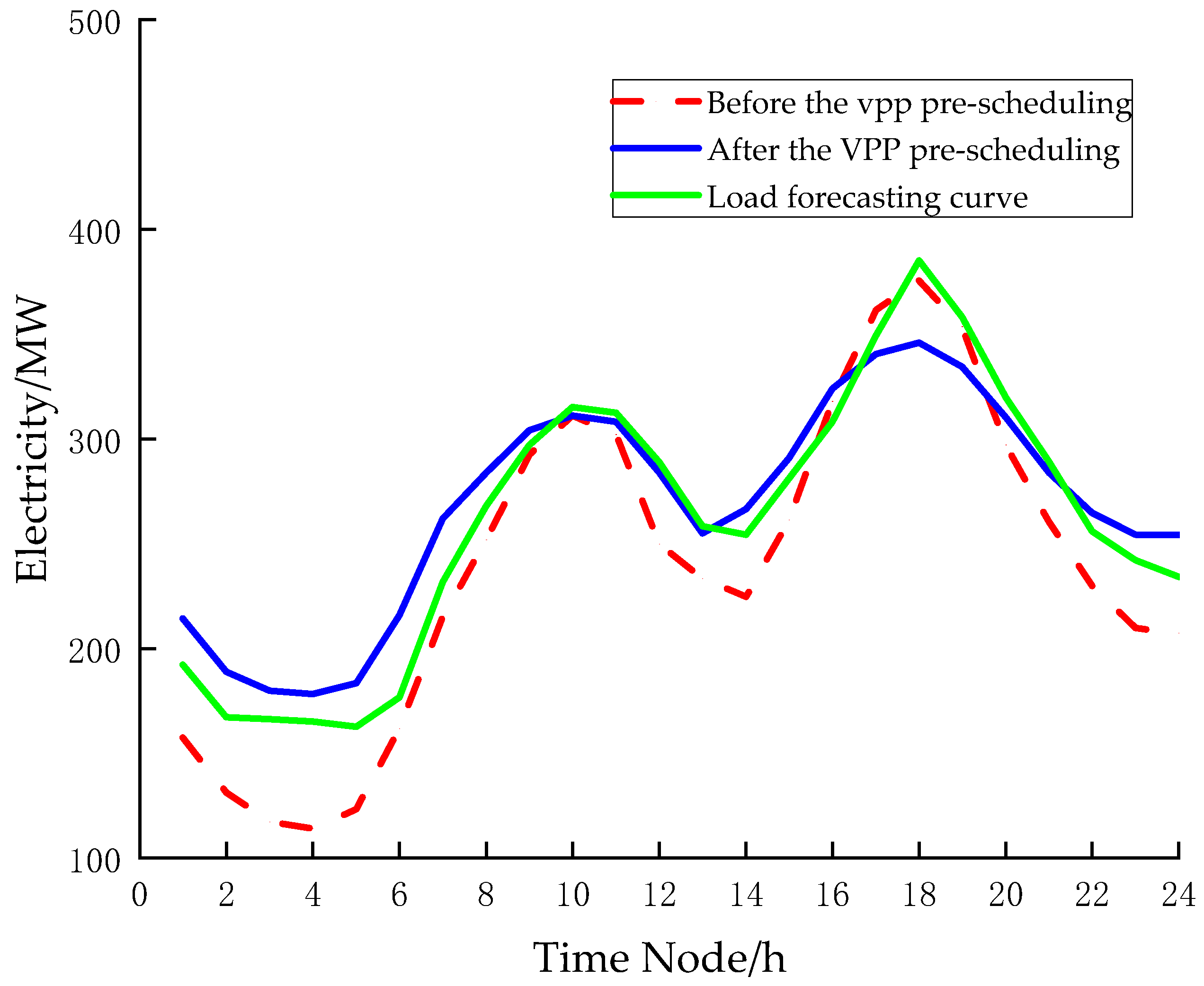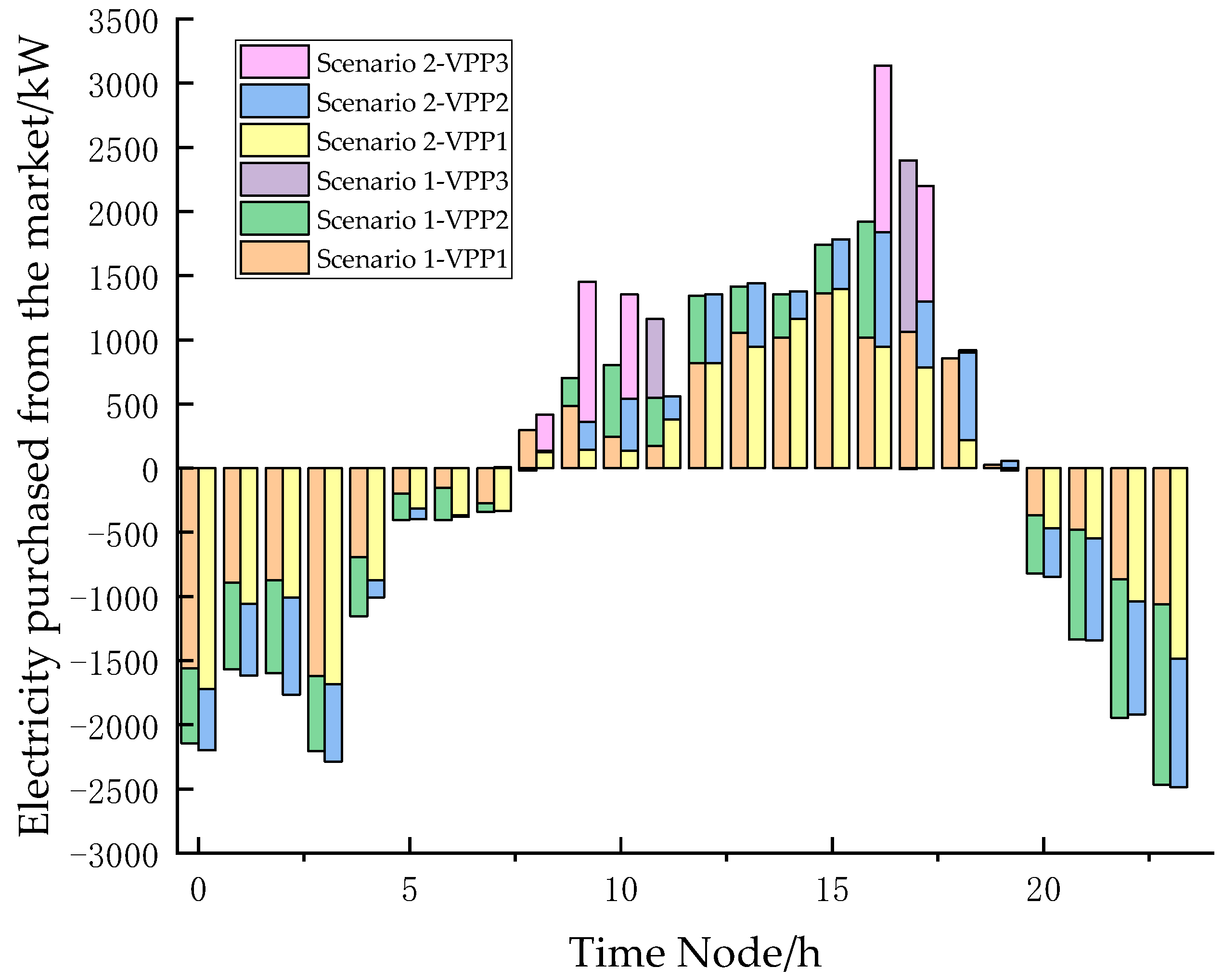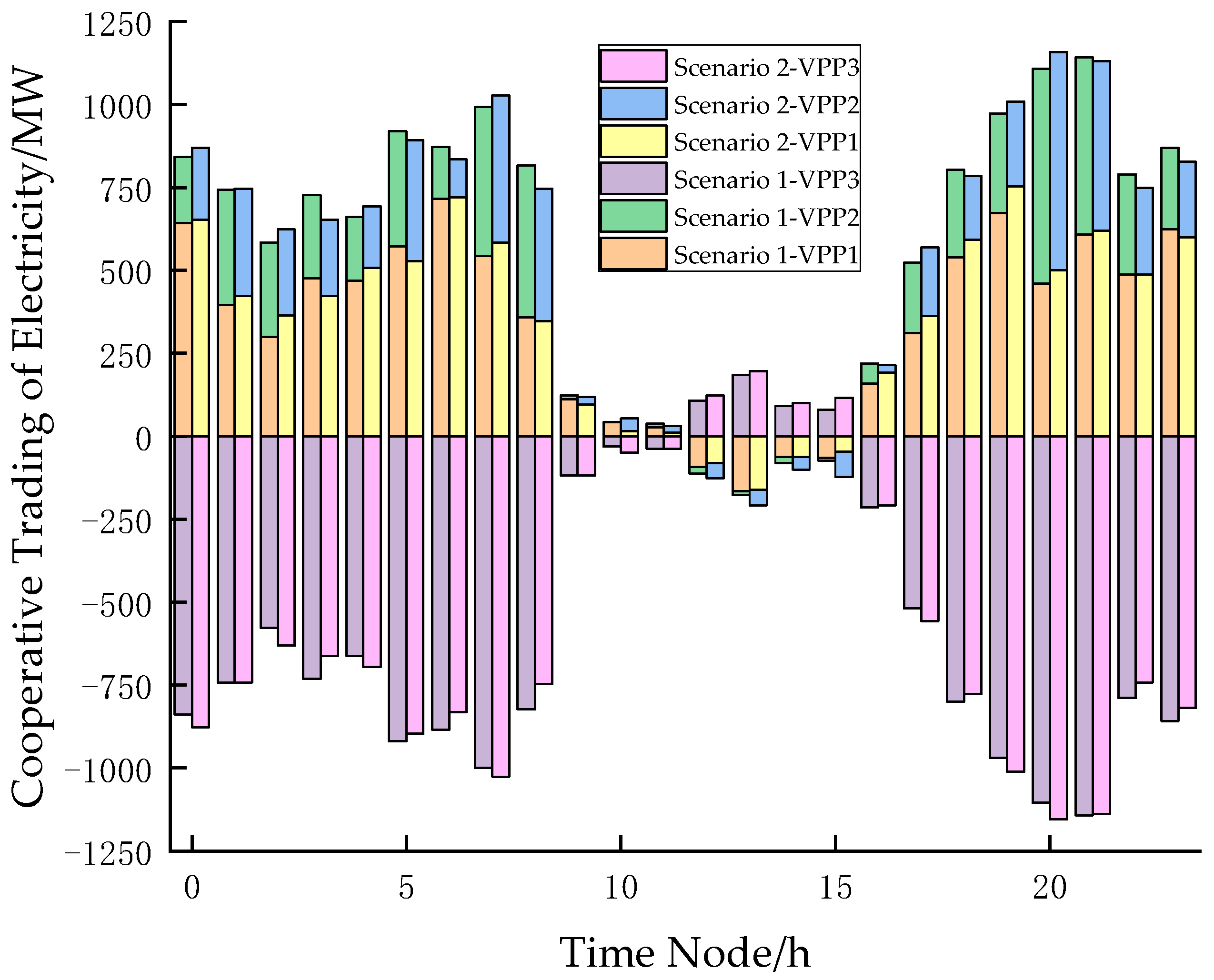1. Introduction
As the proportion of renewable energy generation rises and various distributed energy sources are connected to the power grid, the stability of the power system puts forward greater requirements. Therefore, in order to enable the participation of various renewable energy sources in the power system, it is necessary to utilize advanced communication and cooperative control technologies, and the proposal of the virtual power plant provides a solution to the above problems [
1]. Moreover, with the in-depth study of the components of the power system, an overview of the history and concepts of the digital transformation of the power system is provided, exploring the latest digital technologies, such as cloud computing, the Internet of Things, blockchain, digital twins, and so on, which have contributed greatly to the development of the virtual power plant (VPP) [
2].
In selecting VPPs within regional grids, Xia and Wu considered the spatio-temporal characteristics of electricity transmission and trading, but there is also a conflict of interest between multiple VPP subjects as the region expands [
3]; Li and Wang established the optimal scheduling model of multi-virtual power plants containing electric energy storage, demand response, and hydrogen energy storage, and they propose the corresponding scheduling scheme using the master–slave game theory [
4]; Chen and Wei established the relevant operation model from the theory of master–slave cooperative game based on the cooperative control technology that VPP relies on [
5]; Wang and X propose a two-stage repair strategy for resilient recovery, which is used for the rapid recovery of the electricity-heating integrated energy system after extreme weather events. The core idea is to improve the recovery efficiency of the system by coordinating maintenance scheduling and network reconfiguration [
6]. The above literature mainly focuses on the synergistic optimization between multi-VPP subjects, while ignoring the impact on the environment.
Aiming at the dual-carbon goal, studying the low-carbon operation of multi-VPPs has gradually turned into a research focus of many scholars. Rajasegharan and Veena focused on optimizing the performance of VPP in managing decentralized clean energy sources, and the model uses a distributed control approach and a learning reinforcement technique based on particle swarm optimization [
7]; Su and Wang proposed an optimal scheduling model of a virtual plant based on stepwise carbon trading [
8]; Wang and Du proposed the carbon market trading with the VPP deviation appraisal cost minimization as the goal and participate in the bidding and scheduling strategy in the spot market [
9]; Zhang and Bai introduced cogeneration units with carbon capture integration flexible operation mode in the system and constructed a cogeneration optimal scheduling model for virtual power plants [
10]. In the studies mentioned above, the average carbon emission factor based on the region is used, and the difference between the carbon emission factors of different nodes is not taken into account.
In terms of the main algorithms used for multi-VPPs to participate in market competition [
11,
12], proposed a fitting approach based on a Kriging meta-model instead of internal renewable energy management and proposed a solution method combining a Kriging meta-model and genetic optimization algorithm, which simplifies the amount of computation while solving the equilibrium solution of both parties to obtain the trading tariffs and outputs of VPPs; Zhong and Zhang established a two-layer optimization model to guide VPPs to participate in the grid or distribution network based on the electricity–carbon price, with the upper layer model adopting the adaptive step-size alternating-direction multiplier method to realize the distributed solution among multiple VPPs [
13]; Shen and Han adopt the Lagrangian dyadic relaxation method to substitute the nonlinear part in the optimization model [
14]. In the previous literature, the privacy of individual VPPs is not fully considered when pursuing the speed and efficiency of model solving. In a joint electricity–carbon market where multiple VPPs are involved, the speed of the solution needs to be considered along with a higher privacy approach.
In the current research, most scholars or studies have looked at the power side and studied its carbon emissions, ignoring the share of consumer loads in the grid that are the recipients of electrical energy [
15]. Due to the uniqueness of each node, the analysis of different types of nodes helps to understand and analyze where there are differences in carbon emission factors. Especially in the context of multiple distributed energy access, the differences in VPP carbon emission factors at these nodes will become more apparent. Therefore, more in-depth research is needed on carbon emission factors affecting multiple VPP subjects in market bidding and operational strategies.
Considering the above factors, this study proposes a bidding strategy for multi-VPP participation in the joint electricity–carbon market based on the carbon emission factor. First, pre-dispatch is performed based on the load demand of the previous day and the clearing result of the market, and a method is proposed to measure the degree of consistency between the forecasted output and the load level during the dispatch period in terms of the load factor; second, based on the carbon emission theory, the carbon emission factor and tariff are calculated for transmission; an economic dispatch model of the electric power system is constructed with the objective of minimizing the total cost of the VPPs, and the corresponding carbon emission factor and tariff are issued. Considering the participation in the bidding in the joint market, a revenue allocation model based on Nash negotiation theory is built, used to determine the demand of each VPP, and fed back to the upper level.
This study focuses on a virtual power plant demonstration project in Shanxi Province, which is characterized by the integration of decentralized new energy, adjustable loads, and energy storage systems in the province, with a maximum controllable capacity of 1.2 GW through the provincial smart energy platform, with the core of “source, grid, load, and storage” aggregation and participation in the peaking auxiliary service market.
The data collection covers nine counties and districts in three large areas of north–Jinzhong–Jinan, and the energy market conditions are such that the operation of VPPs in Shanxi is subject to the dual incentives of time-sharing tariffs in the provincial spot market (with peak–valley spreads up to 0.6 CNY/kWh) and the FM auxiliary services market (with an average clearing price of 18 CNY/MW-h). At the same time, it needs to adapt to the “medium- and long-term contract power deviation assessment” mechanism, and its revenue model covers capacity subsidy (200 CNY/MW-day), electric energy revenue, and cross-provincial auxiliary service transactions.
Finally, distributed in the way described above in order to realize the reasonable distribution of the benefits of each VPP, the final example analysis shows that the proposed method can effectively reduce the cost and overall carbon emissions of the VPP alliance and each member and improve the carbon emissions of the power system while considering the economic benefits of the VPPs and obtaining good environmental benefits. In summary of the research conducted throughout the study, the following main conclusions are obtained:
- (1)
When multiple virtual power plants (VPPs) considering carbon emission factors participate in joint electricity–carbon market bidding, their bidding strategies can effectively guide individual VPPs to optimize generation schedules, coordinate internal resources, and enhance cross-VPP collaboration. This approach not only improves overall economic performance but also significantly reduces system carbon emissions through pre-dispatch and dynamic adjustments, achieving dual objectives of economic and environmental benefits.
- (2)
By applying an asymmetric Nash bargaining model, the profit distribution is determined based on members’ marginal contributions to the VPP coalition’s collaborative operation. This contribution-based allocation mechanism ensures fairness in cooperation, establishing a foundation for the sustainable and stable operation of the VPP alliance.
The structure of this paper is organized as follows:
Section 2 presents the multi-virtual power plant (multi-VPP) cooperative gaming framework, including presenting a load factor-based pre-scheduling model, analyzing operational modeling under asymmetric Nash negotiations, and discussing system constraints.
Section 3 details the proposed model solution methodology with the upper-level model, the lower-level model, and the two-layer solution approach.
Section 4 provides comprehensive case analyses to validate the proposed approach. Finally,
Section 5 concludes the paper with the main findings and future research directions.
2. Multi-Virtual Power Plant Cooperative Gaming
The joint electricity–carbon market covers the electricity market, the carbon market, and the cloud service platform of the joint electricity–carbon market. Within the joint market, the stable and secure operation of the electricity market and carbon market is ensured [
16]. The VPP alliance contains two parts, the multi-VPP and the cooperative gaming electricity–carbon trading center.
Figure 1 shows the schematic diagram of multi-VPP participation in the operation of the joint electricity–carbon market.
In the joint electricity–carbon market, both markets optimize their operational strategies based on their respective energy attributes. To address the challenge of leveraging VPPs for electricity–carbon coordination, this study proposes a novel joint trading framework powered by cloud computing technology.
The framework enables VPPs to participate in market operations by uploading transaction data to a centralized platform. Within the VPP alliance structure, the cloud platform aggregates agreed-upon tariffs and power volumes from member VPPs. After processing these data via an information network, it determines the final transaction amounts.
To ensure accuracy, the platform dynamically updates electricity prices and carbon emission reductions in real time, reflecting current alliance demand. Finally, transaction results are distributed to each VPP through a secure communication network.
Within the VPP alliance framework, each member coordinates its internal power generation assets, renewable energy units, and energy storage systems in response to the upper market electricity demand. By simultaneously submitting generation plans and participating in carbon market transactions, members ensure compliance with emission requirements while optimizing resource utilization across interconnected regions. This coordinated approach enables the multi-VPP alliance to effectively participate in joint electricity–carbon markets, achieving optimal resource allocation through collective optimization that balances energy supply with environmental objectives [
17].
2.1. Pre-Scheduling Within the VPP System
2.1.1. Pre-Scheduling Strategies Within the VPP System
Wind power and photovoltaic power, as important components of new energy generation, are characterized by randomness, volatility, and intermittency, making their output difficult to predict accurately. To better ensure the safe and stable operation of the power grid and enhance the capacity for absorbing new energy, wind power and photovoltaic power need to participate in the day-ahead generation dispatching of the power grid, so as to keep their output within a reasonable range and match the overall load demand of the system.
First, the day-ahead scheduling process is shown in
Figure 2.
Upon receiving wind and photovoltaic power forecast data, the grid dispatch center initiates a correction process to account for prediction inaccuracies inherent to renewable energy forecasting. The center employs an integrated approach combining historical performance data, meteorological correction models, and real-time grid operating conditions to refine the renewable generation forecasts. Concurrently, system operators incorporate load forecasts and conventional generation schedules from thermal to maintain overall system power balance.
Following this comprehensive adjustment process, the dispatch center revises the day-ahead generation schedule and updates the grid dispatch system with the corrected plan. These refined forecasts serve dual purposes: they establish reference output levels for renewable energy plants in the subsequent operating day while simultaneously providing critical input for real-time dispatch decisions. The updated schedule enhances operational reliability by better aligning anticipated renewable generation with actual system conditions.
The core of the intraday generation plan is based on load data and wind and solar forecast data and is updated in a high-frequency cycle to ensure the efficient consumption of new energy and the stable operation of the grid, and the specific process is shown in
Figure 3.
The intraday scheduling process begins with real-time load data acquisition. Grid loads exhibit dynamic fluctuations influenced by multiple factors, including temperature variations, industrial production cycles, and residential consumption patterns. To accurately predict near-term power demand, dispatch centers continuously monitor load data while employing short-term forecasting models for rolling updates.
Concurrently, wind and solar farms provide high-frequency intraday forecast updates, typically at 15 min intervals. These forecasts offer superior temporal resolution compared to day-ahead predictions and incorporate real-time meteorological data to enhance accuracy.
Wind power forecasts demonstrate particular stochastic characteristics, with output variability increasing significantly during strong wind conditions or rapid wind speed changes. These conditions often produce noticeably high-frequency oscillations in the power curve. Photovoltaic generation, while generally following more predictable diurnal patterns aligned with solar cycles, can still exhibit substantial variability during cloud cover transitions or sudden weather changes that affect solar irradiance.
The intraday real-time scheduling process framework is shown in
Figure 4.
The overall framework regarding pre-scheduling within VPPs is shown in
Figure 5.
2.1.2. Pre-Scheduling Model Based on Load Factor
Along with the access to renewable energy and various distributed energy sources in the power grid, the stability of the whole power system and the rational utilization of resources are facing serious challenges. In response to the serious phenomenon of wind and light abandonment in the existing system, it is necessary to adopt a suitable strategy to reduce the internal rate of wind and light abandonment and increase the rate of new energy consumption.
Pre-dispatch is performed based on the previous day’s load demand and market clearing results, and a method is proposed to measure the degree of consistency between the forecasted output and the load level during the dispatch period in terms of the load factor, and the standardized value of the VPP output during the dispatch period is calculated as shown in Equation (1):
where
and
represent the nominal value of the VPP output and the nominal value of the load signal at time
t;
represents the actual output of the
i-th VPP at time
t;
represents the maximum output of the
i-th VPP at time
t;
represents the actual value of the load demand at the node at time
t.
Comparing the output and load of the VPP in the grid aims to calculate the deviation of the above two at a certain moment in time, which is calculated as shown in Equation (2):
Load tracking factor is defined as shown in Equation (3):
When the value of the calculation result is closer to 1, it means that at that moment in time, the VPP is in line with the load demand, and when the value is further from 1, it means that the output of the VPP is not in line with the load demand and internal scheduling is required.
The pre-scheduling of each VPP within the system begins with the value of the above load tracking factor, followed by pre-scheduling, calculated as shown in Equation (4):
where
represents the scalar value of the scheduling quantity of the
ith VPP at time
t;
represents the threshold value of the load tracking coefficient.
The significance of setting the threshold value is to prevent the VPP from having too large a difference between the output curve and the load curve at a certain point in time, which affects the amount of offer quotes within the whole VPP system and thus affects the revenues of the whole VPP alliance; thus, the minimum of the total number of dispatches and the maximum of the value of the dispatches in that time period can be taken as an objective function in this stage, and the ratio of the power inequality measure to the total load level is taken as a constraint to carry out the pre-scheduling.
2.2. Operational Modeling of Multi-VPP Cooperation Under Asymmetric Nash Negotiations
Among the VPPs selected in this paper, gas turbines, wind turbines, photovoltaics, energy storage, and part of the interruptible loads are mainly selected as the research objects. When participating in the operation of the multi-market, the VPP carries out cooperative transactions within the VPP to satisfy the needs of each internal equipment unit while optimizing the synergy with the other VPPs.
Multi-VPP Optimized Operational Model
The objective function is the total cost, which is mainly considered to be composed of fuel costs, electricity trading costs, carbon trading costs, and equipment maintenance costs, and is based on the minimization from the total cost as the objective function,
where
represents the fuel cost of the
i-th VPP at time t;
represents the transaction cost of electricity for the
i-th VPP at time
t;
represents the carbon transaction cost of the
i-th VPP at time
t;
represents the operating and maintenance cost of the equipment of the
i-th VPP at time
t.
Fuel costs are dominated by the natural gas consumed by the gas turbines and fuel cells within the system. This is shown in Equation (6):
where
represents the power produced by the gas turbine at time
t;
represents the power produced by the fuel cell at time
t;
represents the fuel consumption per unit of energy of the gas turbine;
represents the fuel consumption per unit of energy of the fuel cell;
represents the energy efficiency of the fuel cell at time
t;
represents the unit price of natural gas.
Electricity transaction costs mainly consist of transaction costs between individual VPPs and the rest of the VPPs in the system, as well as transaction costs with the higher-level grid. This is shown in Equation (7):
where
represents the amount of electricity traded between VPPs;
represents the cost of electricity traded between VPPs and the grid;
represents the negotiated tariff between VPPs;
represents the power flow between VPPs;
represents the traded tariff between VPPs and the grid;
represents the power flow between VPPs and the grid.
The cost of carbon emissions mainly consists of the cost of trading carbon allowances between VPPs and the higher-level energy centers. Each VPP entity has a certain amount of government-issued carbon allowances, and after completing the internal clearance of carbon allowances within its own system, it can choose to sell the excess carbon allowances to the higher-level energy centers or complete the trading of carbon allowances with the rest of the VPP system. This is shown in Equation (8):
where
represents the cost of carbon trading between VPPs;
represents the cost of carbon trading between VPPs and energy centers;
represents the price of carbon allowances between VPPs;
represents the volume of carbon traded between VPPs;
represents the price of carbon between VPPs and energy centers;
represents the volume of carbon traded between VPPs and energy centers;
represents the amount of carbon allowances that are free of charge to VPPs;
represents the actual carbon emissions of VPPs.
Also,
where
represents the amount of electricity supplied to the internal load of the
ith VPP at time t;
represents the amount of electricity purchased from the grid by the
ith VPP at time t;
represents the output power of the gas turbine inside the
ith VPP at time
t;
represents the carbon emissions per unit of electricity supplied by the
ith VPP to the
jth VPP at time
t;
,
, and
represent the fixed parameters set.
The equipment within the VPP mainly involves interruptible loads, energy storage, and gas turbines. The operation and maintenance costs of the equipment are also mainly centered around the above equipment. The energy storage element involves the charging and discharging process, with the corresponding charging and discharging equipment maintenance costs. The total cost function and the cost function of each piece of equipment are shown in Equation (10):
where
represents the cost of the interruptible load;
represents the cost of the storage device;
represents the cost of the gas turbine;
represents the interruptible load type parameter;
represents the amount of interruption of the interruptible load;
and
represent the charging and discharging power of the storage device;
represents the charging and discharging efficiency;
represents the cost of the call of the storage device;
,
, and
represent the fixed parameters of the setting.
2.3. Restrictive Condition
In this paper, the main body of the selected VPP, mainly selected gas turbines, wind turbines, photovoltaics, energy storage, and part of the interruptible load, for the study of the composition of the object, can be analyzed in various aspects of the transaction. This paper intends to study, in order to participate in the transaction of the multifaceted market, VPPs within cooperative transactions, to meet the needs of the internal units of each device at the same time and optimize synergies with the rest of the VPP to ensure the most optimal use of resources.
Power balance:
where
represents the use of distributed energy in the
i-th VPP at time
t;
represents the PV output in the
i-th VPP at time
t;
represents the wind power output in the
i-th VPP at time
t.
Interruptible load constraints [
18]:
where
represents the maximum number of interruptions for the interruptible load;
represents the amount of time the interruptible load has been in the interruptible state;
represents the maximum interruptible time;
represents the number of interruptions for the interruptible load;
represents the interruptible limit;
represents the state of the interruptible load.
Gas turbine constraints:
where
represents he maximum value of the gas turbine output;
represents the minimum value of the gas turbine output;
represents the operating status of the gas turbine;
represents the climbing constraint of the gas turbine.
Energy storage constraints:
where
represents the charge state of the energy storage unit at time
t;
and
represent the state quantity of the energy storage unit charging and discharging, where the state value is set to 0/1;
represents the rated capacity of the energy storage unit;
and
represent the minimum and maximum values of the charging power of the energy storage unit;
and
represent the minimum and maximum values of the discharging power of the energy storage unit;
and
represent the minimum and maximum values of the charge state of the energy storage unit.
Price constraints:
where
represents the price of electricity between VPPs;
represents the price of electricity between VPPs and the grid;
represents the price of carbon allowances between VPPs;
and
represent the minimum and maximum price of electricity between VPPs;
and
represent the minimum and maximum price of electricity between VPPs and the grid;
and
represent the minimum and maximum price of carbon allowances between VPPs.
In addition to satisfying the above price constraints, preventing degradation of the problem and direct trading of VPPs with the electricity market requires the following:
- (1)
The price of electricity traded between VPPs has to be between the prices of electricity in the external market;
- (2)
The price of carbon allowances traded between VPPs has to be between the prices in the carbon market.
The inequality constraints are satisfied as follows,
where
represents the price of electricity sold to the grid by the VPP in the system at time t;
represents the price of electricity purchased from the grid by the VPP in the system at time t;
represents the price of carbon allowances sold to energy centers by the VPP in the system at time t;
represents the price of carbon allowances purchased from energy centers by the VPP in the system at time t.
Considering the joint electricity–carbon market, the asymmetric Nash negotiation model is as follows,
where
represents the cost of cooperative status;
represents the cost of independent operation.
5. Conclusions
The bidding strategy for multi-VPP participation in the operation of the electricity–carbon joint market based on the carbon emission factor involved the pre-scheduling of each VPP main body in the stage with scheduling, pre-scheduling based on the load demand of the previous day and the results of the market clearing, and proposing a method to measure the degree of consistency between the forecasted output and the load level of the scheduling period in terms of the load coefficient; after that, utilizing the theory of carbon emission and taking into account the effect of the variability of the carbon emission factor, the two-layer game model was established. This two-layer game model was for multi-VPPs to participate in the electricity–carbon joint market, in which a cooperative game is used within the VPP coalition and following a revenue allocation method based on product contribution; finally, the model is solved using AA-ADMM to obtain the results. By calculating and analyzing the selected examples, the following conclusions are obtained:
- (1)
The bidding strategy of multi-VPPs participating in the operation of the electricity–carbon joint market, taking into account the carbon emission factor, has an important guiding role for each VPP entity to carry out pre-scheduling, adjust its own power generation plan, call for internal resources, and deepen the cooperation among VPPs, thus reducing overall carbon emissions and taking into account the economic benefits while also considering the environmental benefits.
- (2)
Utilizing the asymmetric Nash bargaining method to distribute revenues based on the contribution degree within the VPP alliance and reasonably distributing the revenues with reference to the contribution degree are conducive to the long-term and stable operation of the VPP alliance.
This paper assumes that members within a VPP alliance are able to collaborate seamlessly, but there are several challenges that may exist in actual practice. First, communication delays may lead to lags in real-time dispatch instructions, affecting the efficiency of the alliance’s response to grid demand. Second, data privacy issues may hinder the sharing of sensitive information, such as generation and load among members, especially in competitive markets where participants may conceal real data for commercial interests.
To address these issues in the future, this paper proposes the following directions: (1) the use of edge computing and distributed optimization algorithms to reduce the reliance on centralized communication, thereby reducing latency and improving robustness; (2) the use of federated learning or differential privacy techniques to achieve collaborative optimization while protecting data privacy; and (3) the consideration of resilient option contracts. The electricity market can introduce a “resilient capacity market”, where VPPs commit by signing contracts to provide backup capacity in extreme events and obtain long-term returns. Dynamic carbon footprint accounting is necessary during the post-disaster recovery stage, when the energy scheduling of VPP may rely on high-carbon resources. It is necessary to design dynamic carbon accounting rules, allowing for short-term high emissions but providing subsequent low-carbon compensation.

